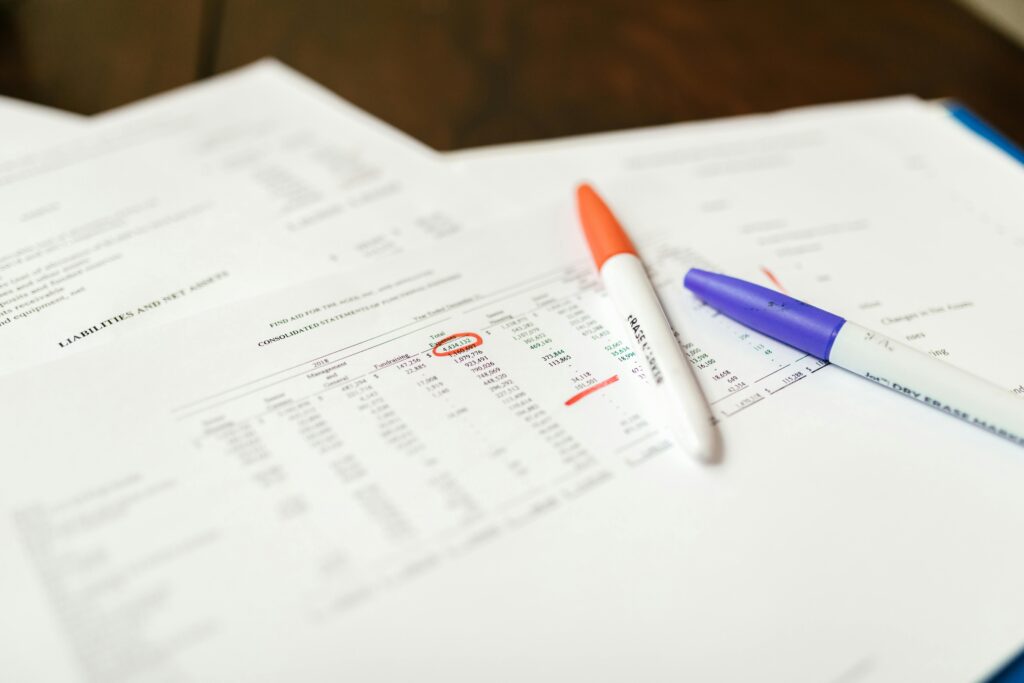In today’s fast-paced business world, understanding and interpreting financial statements is crucial for the success of any organization. Whether you’re a business owner, investor, or manager, these financial documents provide valuable insights into a company’s financial performance, profitability, and overall health. Financial statements not only help businesses make informed decisions but also enable external stakeholders such as investors, creditors, and regulatory authorities to assess the company’s standing.
This blog post will guide you through the different types of financial statements, their components, and how they are used to evaluate the financial condition of a business. We’ll also discuss why these statements are important and how they can drive strategic decision-making.

What are Financial Statements?
Financial statements are structured records of the financial activities and position of a business, providing a summary of its performance over a specific period (e.g., quarterly or annually) or at a given point in time. These statements serve as a tool for internal and external stakeholders to gauge the financial health of an organization and make informed decisions.
There are three primary types of financial statements, each providing unique insights into a company’s financial performance and position. These are:
1. Income Statement (also known as the Profit & Loss Statement)
The Income Statement is one of the most important financial documents a company can produce. It shows a company’s financial performance over a specific period, typically a quarter or a year. The statement summarizes revenues, expenses, and profits or losses during that time frame, ultimately showing whether the company is profitable or not.
This statement is vital for business owners, investors, and managers because it offers insight into how well a company is generating revenue from its core activities, and whether it is controlling its expenses effectively to produce a profit.
2. Balance Sheet
The Balance Sheet is a snapshot of a company’s financial position at a specific point in time, typically at the end of a fiscal period. It outlines what the company owns (assets), what it owes (liabilities), and the equity of its owners or shareholders.
The Balance Sheet follows the basic accounting equation: Assets = Liabilities + Equity. This equation must always balance, meaning a company’s assets are financed by either borrowing money (liabilities) or through the capital invested by the owners (equity).
Understanding the balance sheet helps business owners and external stakeholders assess the financial stability of a company, including its liquidity (ability to pay short-term obligations) and financial leverage (debt levels).
3. Cash Flow Statement
The Cash Flow Statement provides a detailed view of the actual cash inflows and outflows of a business during a given period. Unlike the income statement, which may include non-cash items (such as depreciation or credit sales), the cash flow statement focuses only on cash transactions. It is divided into three main sections:
- Operating Activities: Cash generated from the company’s core business activities, such as sales and payments from customers.
- Investing Activities: Cash used for investments in assets like property, equipment, or securities, as well as proceeds from the sale of such assets.
- Financing Activities: Cash received from raising capital through debt or equity or cash used for repaying loans and paying dividends.
The Cash Flow Statement is critical for understanding how a company manages its cash, which is essential for meeting financial obligations, making investments, and sustaining operations.
These three financial statements, when analyzed together, provide a comprehensive view of a company’s financial health. While the Income Statement shows profitability, the Balance Sheet gives insight into the company’s financial position, and the Cash Flow Statement reveals the company’s liquidity and cash management. Understanding these financial statements is crucial for anyone involved in business decision-making, from internal managers to external investors and creditors.
Each of these statements offers a unique perspective on the business’s financial performance, and together they provide a comprehensive overview of its financial condition.
1. Income Statement (Profit & Loss Statement)
The Income Statement is one of the most critical financial statements because it shows a company’s ability to generate profit over a period. It summarizes the revenues, expenses, and profits or losses over a specific period, such as a quarter or a year.
Key Components of an Income Statement:
- Revenue (Sales): This is the total income from goods or services sold, before any expenses are subtracted.
- Cost of Goods Sold (COGS): This refers to the direct costs associated with the production of goods or services sold by the company. For example, if a company manufactures products, the cost of raw materials and labor would be included here.
- Gross Profit: This is calculated as revenue minus the COGS. It shows how much the company earned from its core operations before other expenses.
- Operating Expenses: These include selling, general and administrative expenses (SG&A), marketing costs, rent, utilities, and salaries.
- Operating Income: This is calculated by subtracting operating expenses from gross profit.
- Other Income/Expenses: These can include items like interest income, gains or losses from investments, or one-time income from the sale of assets.
- Net Income (Profit or Loss): This is the bottom line. It represents the company’s total earnings after all expenses, taxes, and interest are deducted from the revenue. A positive net income means the company made a profit, while a negative net income signifies a loss.
Why is the Income Statement Important?
The Income Statement is crucial for:
- Assessing profitability: Helps businesses understand if they are generating enough income to cover their costs.
- Tracking performance over time: By comparing income statements across different periods, businesses can identify trends in revenue, expenses, and profits.
- Making decisions about cost management: It provides clarity on which areas of the business need cost reduction or investment to increase profitability.

2. Balance Sheet
The Balance Sheet is a snapshot of a company’s financial position at a specific point in time. It shows what a company owns (its assets), what it owes (its liabilities), and the difference between the two (its equity).
The balance sheet follows the accounting equation:
Assets = Liabilities + Equity
This equation must always balance, ensuring that the company’s assets are financed by liabilities and equity.
Key Components of the Balance Sheet:
Assets
Assets are the resources owned by a company that are expected to provide future economic benefits. Assets are categorized into two main types: Current Assets and Non-Current Assets.
- Current Assets: These are assets that are expected to be converted into cash or used up within a year. Current assets are crucial for assessing a company’s short-term liquidity and ability to meet its immediate financial obligations. Common examples of current assets include:
- Cash: This includes physical currency, bank balances, and other cash equivalents that are available for immediate use.
- Accounts Receivable: This refers to amounts owed by customers for goods or services already provided but not yet paid for.
- Inventory: Goods that are held for sale in the normal course of business, such as raw materials, work-in-progress, and finished goods.
- Non-Current Assets: These are long-term assets that are not expected to be converted into cash or used up within one year. Non-current assets are typically important for long-term business operations and growth. They are typically listed at their cost, minus accumulated depreciation (for tangible assets). Examples include:
- Property, Plant, and Equipment: Tangible assets like land, buildings, machinery, and vehicles that are used in the production process or to carry out business operations.
- Intangible Assets: Non-physical assets such as patents, trademarks, copyrights, and goodwill, which can add significant value to a company.
- Long-Term Investments: Investments made in other companies or assets that are expected to generate returns over a longer time horizon.
Liabilities
Liabilities represent the company’s financial obligations or debts owed to external parties, such as creditors, suppliers, and lenders. Liabilities are categorized into Current Liabilities and Non-Current Liabilities, based on the due date of repayment.
- Current Liabilities: These are debts that are due to be settled within one year. Current liabilities are used to gauge a company’s short-term financial health and liquidity. Common examples include:
- Accounts Payable: Money owed to suppliers for goods or services that have been received but not yet paid for.
- Short-Term Loans: Loans or lines of credit that must be repaid within a year.
- Accrued Expenses: Expenses that have been incurred but not yet paid, such as wages, taxes, and interest.
- Non-Current Liabilities: These are long-term obligations that are due after more than one year. Non-current liabilities are often used to finance large investments or capital projects. Examples include:
- Long-Term Debt: Loans or bonds that are due for repayment after one year, often with a fixed interest rate.
- Pension Liabilities: Obligations related to employee retirement benefits that are due in the future.
- Deferred Tax Liabilities: Taxes that are owed but are not yet due for payment, typically arising from differences in accounting treatment for tax purposes.
Equity
Equity represents the residual interest in the assets of a company after deducting its liabilities. In simple terms, equity is the value that would be left for the owners or shareholders if the company sold all its assets and paid off all its liabilities. Equity can be broken down into two primary components:
- Owner’s Equity or Shareholder’s Equity: This refers to the amount of money invested in the company by the owners or shareholders. It can also include additional contributions or withdrawals made by the owners. In publicly traded companies, this equity is represented by the shares held by the shareholders. Owner’s equity reflects the company’s net worth or book value.Components of owner’s equity include:
- Paid-in Capital: Money invested by the owners or shareholders in exchange for stock or ownership shares in the company.
- Additional Paid-in Capital: Any money received from the sale of stock above its par value.
- Retained Earnings: This is the portion of profits that a company has reinvested into the business, rather than distributing it as dividends to shareholders. Retained earnings accumulate over time as the company generates profits and retains them for reinvestment in operations, debt repayment, or expansion. Retained earnings can be used for a variety of purposes, such as funding new projects, paying off liabilities, or strengthening the company’s balance sheet.
The Accounting Equation
The relationship between assets, liabilities, and equity is governed by the accounting equation:
Assets = Liabilities + Equity
This equation must always balance, as it represents the fundamental principle of double-entry accounting: every transaction affects at least two accounts, ensuring that the company’s financial position is always in equilibrium.
- Assets: What the company owns or controls.
- Liabilities: What the company owes to others.
- Equity: What is left for the owners after liabilities are deducted from assets.
Understanding this equation is crucial for interpreting a company’s financial position and performance. A business’s assets are funded through either debt (liabilities) or ownership investment (equity). The balance sheet reflects the financial structure of the company by showing how its assets are financed.
In summary, assets, liabilities, and equity are fundamental components of a company’s balance sheet and financial health. Assets represent what a company owns, liabilities reflect what it owes, and equity shows the value remaining for the owners. By understanding these categories and how they interrelate, businesses can make informed decisions and track their financial progress effectively.
Why is the Balance Sheet Important?
The Balance Sheet is essential for:
- Assessing liquidity: It helps determine if a company can meet its short-term obligations by looking at its current assets versus current liabilities.
- Evaluating financial stability: The balance sheet provides a clear picture of a company’s debt levels and overall financial health.
- Tracking asset management: It shows the company’s investments and how effectively they are being utilized.
3. Cash Flow Statement
The Cash Flow Statement provides an overview of the cash inflows and outflows during a specific period. Unlike the income statement, which is based on accrual accounting, the cash flow statement focuses solely on actual cash transactions.
Key Components of the Cash Flow Statement:
- Operating Activities: This section reports the cash generated or used by the company’s core operations. It includes cash receipts from customers, payments to suppliers, wages, and taxes.
- Investing Activities: This section reflects cash transactions related to the acquisition or sale of long-term assets, such as property, equipment, or investments.
- Financing Activities: This section includes cash flows related to raising capital or repaying debt. It covers the issuance of stock, borrowing, or paying off loans, and dividend payments.
Why is the Cash Flow Statement Important?
The Cash Flow Statement is crucial for:
- Assessing liquidity: It shows whether a company has enough cash flow to cover its obligations, such as paying bills or repaying loans.
- Understanding cash generation: The statement helps businesses understand how much cash is generated from core operations versus external financing or investment.
- Evaluating cash management: By analyzing cash flow, businesses can identify issues such as negative cash flow or inefficient working capital management, allowing for better financial planning.

The Interplay Between Financial Statements
Although the Income Statement, Balance Sheet, and Cash Flow Statement each provide different insights into a business’s financial situation, they are all interrelated. For example:
- The net income from the Income Statement is carried over to the Balance Sheet as part of the retained earnings.
- The cash flow from operating activities on the Cash Flow Statement adjusts the cash balance on the Balance Sheet.
- Understanding liabilities and equity on the Balance Sheet provides context for how much of the business’s cash is tied up in debt versus equity.
By analyzing all three statements together, businesses can get a complete picture of their financial health, including their profitability, financial position, and cash flow.

Why Are Financial Statements Important?
Financial statements are essential for several reasons:
- Decision Making: They provide data that helps business owners, investors, and creditors make informed decisions about resource allocation, investments, and business strategies.
- Compliance: Accurate financial reporting is required by law, especially for publicly traded companies, to comply with accounting standards and regulations such as GAAP or IFRS.
- Business Performance Evaluation: They allow businesses to assess their strengths, weaknesses, opportunities, and threats, which is essential for strategic planning and growth.
- Attracting Investment: Investors and lenders rely on financial statements to evaluate the profitability, financial health, and growth potential of a business before committing their resources.
- Tax Filing: Financial statements are also required for tax filings, as they show the taxable income and can help optimize a company’s tax liabilities.
Conclusion
Financial statements are vital tools for understanding a company’s financial performance and making informed decisions. The Income Statement, Balance Sheet, and Cash Flow Statement each serve a unique purpose and offer valuable insights into different aspects of a business’s financial health. Together, they provide a comprehensive overview that helps business owners, investors, and other stakeholders assess the company’s overall standing and make data-driven decisions.
Whether you’re managing a small business or overseeing a large corporation, understanding how to read and interpret these statements is key to maintaining financial health, complying with regulations, and positioning your business for long-term success.
If you need assistance in preparing or interpreting your financial statements, don’t hesitate to reach out. At GoWin Accountants Ltd, we offer expert accounting services to ensure your financial records are accurate, up-to-date, and compliant with all relevant standards.
📞 Call us at: 01256 578 106
📧 Email us at: admin@gowinaccountantsltd.co.uk
Let us help you navigate the world of financial statements to ensure your business’s continued growth and success.
This blog post covers the fundamental aspects of financial statements and their importance in business. It should serve as a useful guide for anyone looking to understand how these statements work and how they can benefit their organization.








